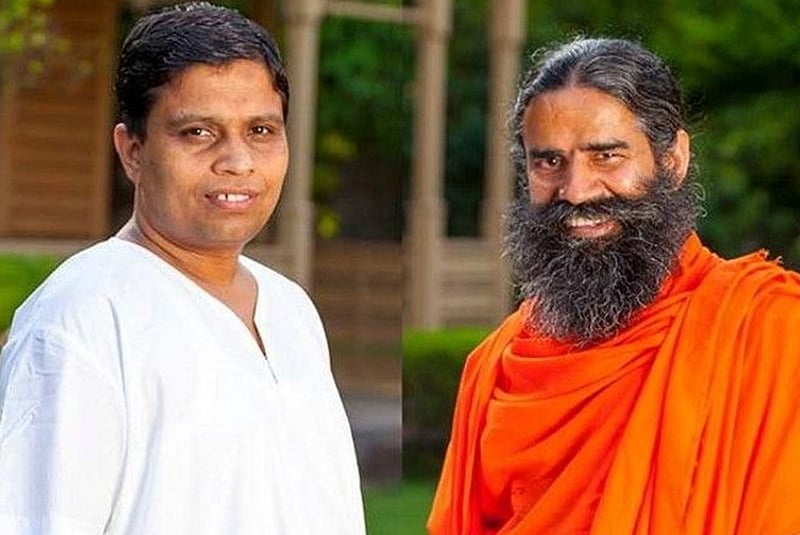Aim of Yoga
-Virtually, Yoga commences after going beyond manas (mind). Beyond mana only, the true existence of self cetana (consciousness) begins. When we ascend above the lower level of mana, then only wholeness, extensiveness and divinity descends in our personality. Our mind, by its nature cultivates biases, dwells on the sorrows of a non-existent past, and formulates innumerable fantasies for the future. We want to live in the known, but being fearful of the unknown, which our mind would not let us cognise or experience, we do not act. This creates a state of mental paralysis towards attempting a new action.
– With the aid of Yoga, we should motivate ourselves towards the target of building a healthy, prosperous and cultured person, family, society, nation and world. 0 We should aim to bring a diseased person towards health, to transform a bhogi (materialist) into a yogi, and mould the healthy towards an useful purpose in life. We should try to reorient humanity towards well-being, efficiency and productivity, positivity, creativity and equip it for experiencing a qualitative change in order to build a progressive, civilized and wealthy society, nation and world.
– We gain happiness and fulfillment when we overwhelm the feelings of kama (lust and sexual desires), krodha (anger), lobha (greed), mada (intoxication), moha (attachment) and matsarya (jealousy). We beget sorrows when one or more of these feelings gain control over our mind. The path of Yoga teaches us the knowledge with which to tame these states of mind, to control these feelings, and to transform the latent energy that lie in dormant state within us into indomitable power.
The original form of Yoga
– Yoga is a practical philosophy. Nowhere in yogic philosophy is a direction that can not be emulated.
– Diyate jnatasadbhavah ksiyate Pasuvasana’, that is, the procedure which transforms animal instincts into divine sentiments is called Yoga. The sadhakas keep practicising the procedure of emotional purusartha (effort) to transform their accumulated kusamkara (bad past impressions) into nobler emotions. They are always immersed into these efforts. The unbroken effort results in most parts of their atma to become oriented towards the Paramatma.
– After freeing the mind of worldly malformations and excess thoughts helps in the realization of mana (mind) and buddhi (intellect) formed from the elements of prakrti (primordial unmanifest matter) and realization of atma and Paramatma. This is Yoga.
– To know the weaknesses of life and to transform them into strengths, thus becoming a person of strength, is ‘sadhana’ (practice). The other name for ‘sadhana’ is Yoga.
– Yoga is that which makes a person worthy.
– The practise of Yoga helps the sadhaka (practitioner) to realise a sharpness of intelligence, judgement and memory. It increases the concentration levels. Yoga helps to control the indriyas (sense organs) like the mind. Yoga helps destroy the panca-vikara, namely lust, anger, greed, attachment and jealousy and the bad-samskara they beget in a person due to ahamkara(egoism). Yoga creates the clean mental environment and refines the strength of will for good-samskara to take birth. This leads to the realisations of peace, joy, satisfaction, fearlessness, happiness and ultimately the state of moksa (liberation).
– The non-practitioner of Yoga generates sorrows for the people around him. Such a person becomes the slave of the mind and the indriyas and therefore unable to understand the subtle subjects taught by the Vedas and expounded by the Gurus and Rsis. The person is not strong enough to handle the sorrows and disruptions that occur due to illnesses, separation, disrespect, losses, treachery, and deaths etc. in the normal course of life. Such a non-yogic person while unable to destroy the ku-samskara of desire, anger, greed, attachment, arrogance and jealousy, cannot enhance the wealth of noble samskaras either. The person’s problems remain unsorted and unsolved.
– The chief grant ha (text) of Yoga is the ‘Yogasutra’ created by Maharshi Patanjali. It is the empirical, scientific, practical and unanimously accepted grantha of Yoga. It has the step-by-step explaination of ‘Astanga-yoga. All the eight principles of Astanga-yoga have to be faithfully practised in a disciplined manner in order that the yoga-sadhana is fruitful.
– Yama (restraints), Niyama (observances), Asana (postures), Pranayama (breathing practices), Pratyahara (withdrawal of senses), Dharana (contemplation), Dhyana (meditation) and Samadhi (Absolute emancipation) are the eight steps of Yoga. That is why it is called ‘Astanga-yoga. No person can become a yogi without a mastery in ‘Astanga-yoga’.
– The path of Astanga-yoga is not a sectarian or communitarian philosophy. Rather, it is a complete method describing the process one has to follow to lead a life of austere efforts. ‘Astanga-yoga’ demonstrates its supremacy in the context of the path of righteousness, spirituality, humanity and science. It is inclusive in its wise consideration of all the states of life a person may find oneself in — from the public dealings in society to the final stages of meditation, the chief purpose of life, which is to realise the immeasurable heights of spirituality culminating in the achievement of samadhi.
– Fulfilling the five universal duties, namely — Ahimsa (non-violence), Satya (truthfulness), Asteya (non-covetousness), Brahmcharya (celibacy) and Aparigraha (non- possessiveness), is called ‘Yama’.
– The conduct of goodness with everyone with body, speech and mind, while giving up the rivalry or hate with every being, is called ahimsa. While science says that the hurt caused in the tongue is the quickest to heal, wisdom says that the lashing caused by the tongue (speech) is never healed. Therefore, we must not hurt any being. Only with the use of good words the hearts of the good and mighty can be won. Therefore, we must always speak good words, even if circumstances force us to take back our words, we should gladly take back our words back, without any discomfort. The practicioner of ahimsa all hatred towards all beings from the mind.









